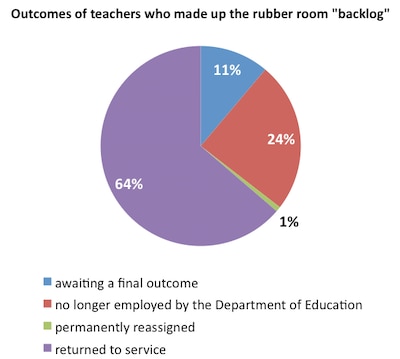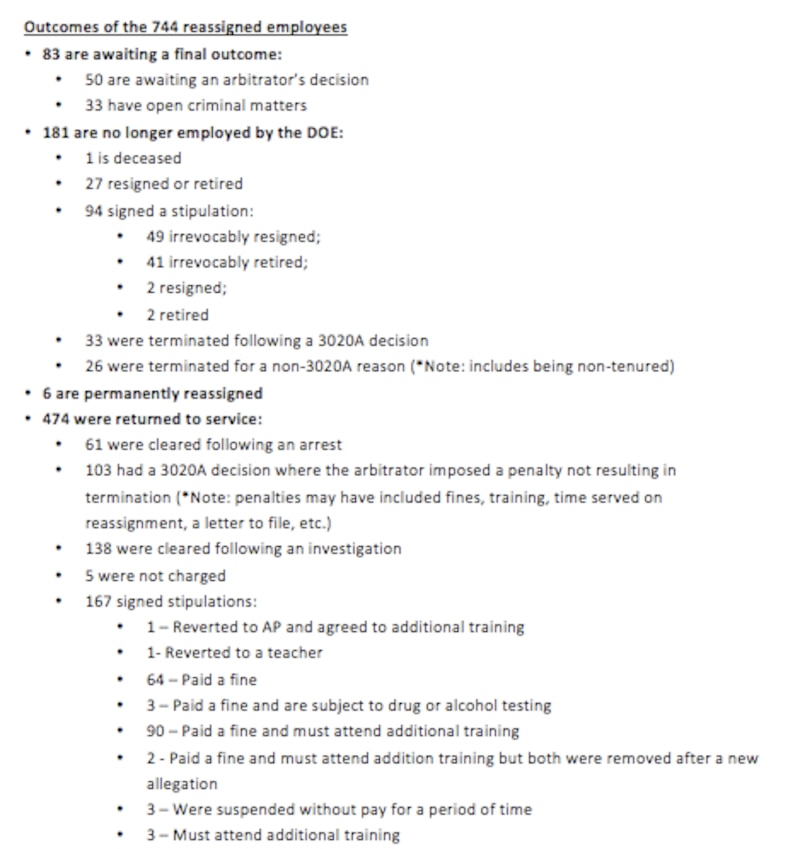
The city gave a glimpse today into the results of its new sped-up process for terminating teachers, the one that the Bloomberg administration said would put an end to the teacher holding pens known as rubber rooms.
The rubber rooms are technically gone; now, most teachers charged of incompetence or misconduct await verdicts in real schools and do administrative work. But the city failed to meet its goal of erasing the “backlog” of teachers who had been removed from their classrooms by the beginning of this calendar year. Roughly 11 percent of the teachers who made up the backlog — 83 out of 744 — are still waiting for their cases to wrap up.
Of those who have completed the process, nearly two-thirds of the teachers charged with misconduct or incompetence have returned to their classes, according to data released today by the Department of Education. Some were cleared of charges; others were fined or assigned additional training or counseling.
Roughly a quarter of those who began the termination proceedings are no longer in schools. Some were fired, and others either were forced to retire or resign.
The new numbers come at a time of heightened tension between the city and its teachers union over how to identify bad teachers and remove them from classrooms.
City officials are lobbying lawmakers in Albany to overturn the state’s seniority-based layoff system and replace it with a system that would dismiss teachers based on judgements of their merit. Union officials have fiercely resisted the proposed changes, arguing that the seniority-based system is the most fair to teachers.
Underlying the city’s push to change layoff rules is a view that the current system makes it very difficult to dismiss a teacher for poor performance. Between 2008 and 2010, city officials have said that they were only able to fire three teachers for incompetence. Teachers accused of misconduct or incompetence faced hearings that sometimes dragged on for months or even years.
In April, the city and teachers union struck their deal to expedite the process by which arbitrators hear and decide the cases of teachers accused of misconduct or incompetence. The union also agreed to a more robust teacher evaluation system, under which teachers who are rated ineffective could face a speedier removal process.
Teachers union president Michael Mulgrew argued today that the percentage of teachers who left the system as a result of disciplinary procedures suggests that the new hearing system is successfully helping rid schools of bad teachers.
“Everyone said we can’t fix this problem, but this problem has been fixed,” Mulgrew said.
The numbers the city released today did not distinguish between teachers disciplined for misconduct and those charged with incompetence, and city spokeswoman Barbara Morgan said the breakdown was unavailable this afternoon. She emphasized in a statement that the city does not see the problem as fixed.
“Ending the rubber rooms was certainly a critical step,” Morgan said in a statement. “However, we have much more work to do to ensure we put in place policies that allow us to keep our best teachers, quickly move the worst out of the system, and put our kids first. That includes ending Last in, First out.”
Union officials said today that roughly 30 percent of the teachers who have left the department through disciplinary hearings over the last two years have done so because of incompetence charges.
Here is the city’s breakdown of the outcomes for 744 teachers reassigned before last September. Teachers who “signed stipulations” agreed to their outcomes before arbitrators issued a decision.

